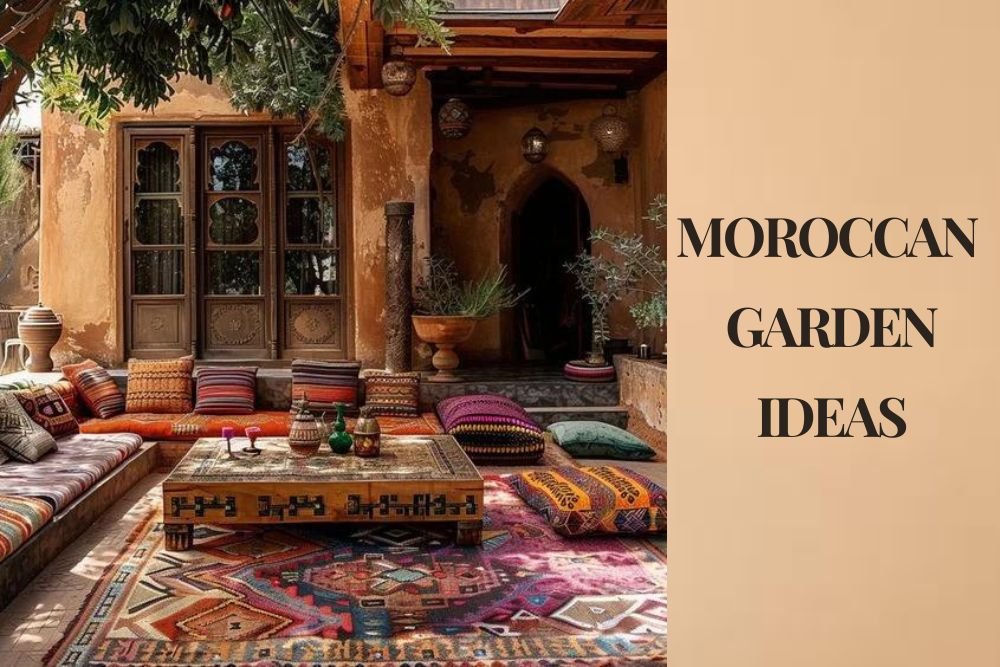Are you looking for Moroccan garden ideas to make a stunning garden? Well, you can find them here. Transforming your ordinary garden into a captivating Moroccan paradise can infuse your outdoor space with exotic charm. Moreover, the Moroccan-style garden incorporates natural elements, such as floral and plant motifs, into its design.
In this article, you will discover how to incorporate the right elements into your garden, unique ideas, and best practices to make a perfect Moroccan-style garden
Best Moroccan Garden Ideas
1. Moorish Tiles
Do you know what makes the best Moroccan garden? Of course, the Moorish tiles! Usually, places with Arid climates require cool surfaces, but when it comes to Morocco, they tend to be colorful as well. So, using Zellige tiles is one of the best Moroccan garden ideas that can create striking geometric patterns on floors, walls, fountains, and other surfaces. Moreover, it can be used on any scale to highlight features or to create a grand entrance.
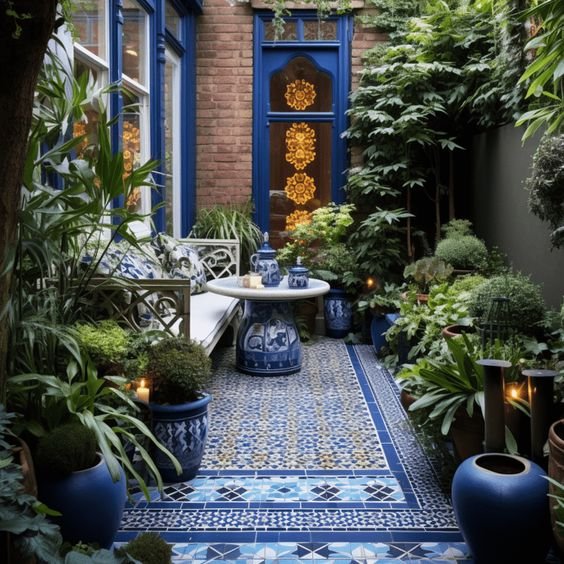
Ideas:
- Geometric Patterns: Use geometric Zellige tiles to create beautiful patterns on floors, walls, and fountains.
- Focal Points: Highlight specific features like a fountain or pathway using Moorish tiles to draw attention.
- Color Contrast: Combine different shades of tiles to create contrasting patterns that enhance visual appeal.
- Custom Designs: Incorporate bespoke designs that reflect traditional Moroccan motifs and craftsmanship.
Best Practices:
- Professional Installation: Hire skilled artisans familiar with Moroccan tile work for precise installation.
- Sealing: Properly seal tiles to protect against weather elements and ensure easy maintenance.
- Regular Cleaning: Establish a cleaning routine to preserve the vibrancy and cleanliness of the tiles.
- Accent Lighting: Use subtle lighting to highlight the texture and patterns of Moorish tiles during evening hours.
- Periodic Inspection: Inspect tiles periodically for cracks or damage and repair them promptly to maintain aesthetics.
2. Vibrant Color Pattern
In the majority of Moroccan gardens, terracotta is used to create a warm and inviting color palette, ranging from soft pinks to fiery reds. The iconic Moroccan tiles are punctuated with cobalt blues, bright reds, etc. creating a warm and inviting palette. Try out these ideas to have eye-catching colors in your garden.
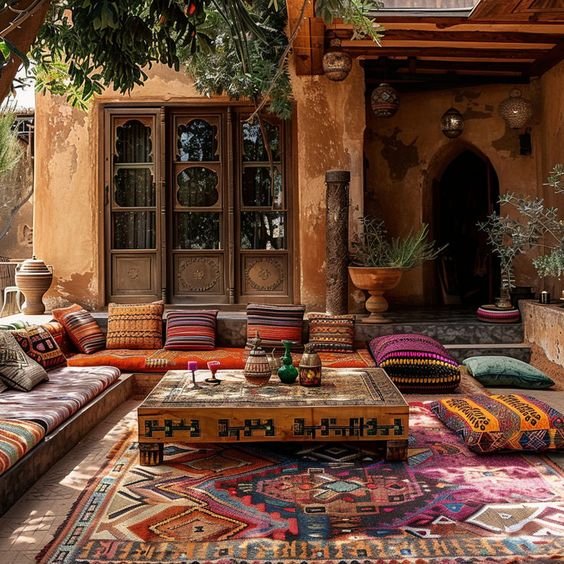
Ideas:
- Color Combinations: The color palette is one of the most important Moroccan garden ideas to incorporate. Use Terracotta, dark reds, and emerald greens in plantings and decor.
- Layering Effect: Use colors to create depth and focal points within the garden landscape.
- Accent Features: Integrate colorful pots, cushions, and textiles to enhance the vibrancy of the space.
- Seasonal Variations: Adjust plantings and decor seasonally to maintain a dynamic and inviting color scheme.
- Natural Integration: Blend vibrant colors with natural elements like stone and wood for a cohesive look.
Best Practices:
- Color Balance: Maintain a harmonious balance of colors throughout the garden to avoid overwhelming visual impact.
- Fade Resistance: Select materials and plants that resist fading under sunlight to preserve color intensity.
- Climate Considerations: Choose plants and materials that thrive in your local climate to sustain vibrant colors year-round.
- Color Psychology: Consider the psychological effects of colors to create desired moods and atmospheres in different garden areas.
3. Evergreen Shrubs
If you are looking for small Moroccan garden ideas, lush greenery is key to structure and appeal. Evergreen shrubs like boxwood, laurel, or bay add depth and contrast, creating an outstanding backdrop to the vibrant colors and exotic elements.
This foundational plant can create a harmonious, visually pleasing space for you and your family by being carefully selected and placed.

Ideas:
- Formal Hedges: Shape shrubs into formal hedges or topiaries to define garden spaces and pathways.
- Contrasting Foliage: Pair evergreens with plants that have contrasting foliage colors and textures.
- Potted Arrangements: Create movable greenery by planting evergreens in large, decorative pots.
- Privacy Screens: Use evergreens strategically to create privacy screens or natural boundaries within the garden.
Best Practices:
- Pruning and Maintenance: Regularly prune shrubs to maintain shape and health throughout the year.
- Watering Needs: Monitor watering requirements to ensure optimal growth and foliage density.
- Soil Quality: Amend soil with nutrients and ensure good drainage to support healthy shrub growth.
- Sunlight Exposure: Consider the sunlight requirements of different shrub species when planning their placement.
- Disease Prevention: Implement preventive measures against common diseases that affect evergreen shrubs in your region.
4. Wrought Iron Decor
Your Moroccan-style garden will look more sophisticated and artistic if you incorporate wrought iron accents such as tables, gates, trellises, or lanterns. Adding these ornate elements to your outdoor space will enhance its exotic charm and blend seamlessly into the overall design.
With its handcrafted details and choice of blue or terracotta designs, the Woodside Postwick Mosaic Garden Table and Folding Chair Set blends elegance with practicality.
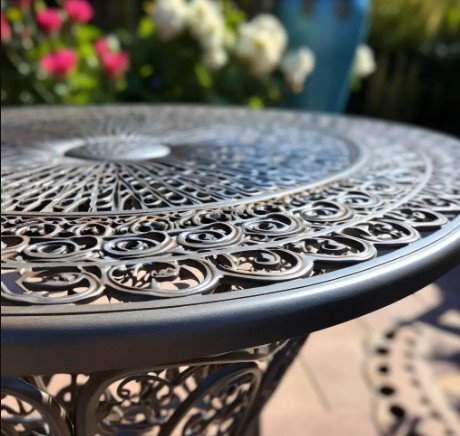
Ideas:
- Functional Furniture: Incorporate wrought iron tables and chairs for dining or seating areas in the garden.
- Lighting Fixtures: Hang wrought iron lanterns or sconces to add ambiance and illuminate pathways.
- Vertical Gardening: Utilize wrought iron trellises for climbing plants or vertical gardens.
- Custom Designs: Commission custom wrought iron pieces that reflect Moroccan design motifs and craftsmanship.
Best Practices:
- Rust Prevention: Apply protective coatings or paints to wrought iron to prevent rust and corrosion.
- Proper Installation: Ensure sturdy installation of wrought iron pieces to withstand outdoor elements.
- Seasonal Maintenance: Regularly inspect and clean wrought iron decor to maintain its appearance.
- Safety Considerations: Smooth out any sharp edges on wrought iron pieces to prevent injuries.
- Compatibility: Coordinate wrought iron pieces with other garden elements to maintain a cohesive design theme.
5. Low Seating
Adding low benches or floor cushions, complemented by lanterns and potted plants, is one of the best Moroccan garden ideas to make a perfect place for reading, sipping tea, or spending time with family and friends.
You can also opt for vintage Moroccan Hanging Lanterns, beautifully crafted from glass and metal, bringing timeless elegance to your seating area.
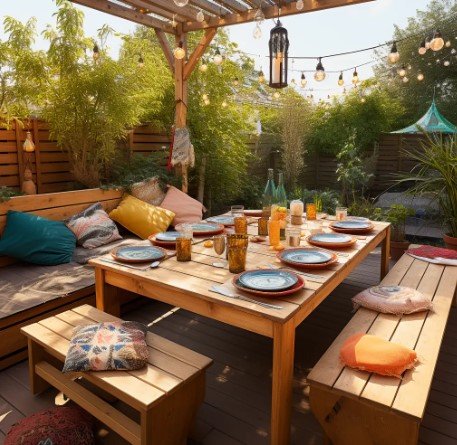
Ideas:
- Cozy Arrangements: Arrange low benches and floor cushions around a central feature like a fountain or fire pit.
- Cultural Influence: Decorate seating areas with Moroccan rugs, cushions, and textiles for authenticity.
- Natural Integration: Place low seating near lush plantings or water features to enhance relaxation.
- Flexible Layouts: Create movable seating arrangements to accommodate different uses and group sizes.
- Privacy Screens: Use low seating to define intimate spaces within the garden for quiet reflection or conversation.
Best Practices:
- Comfort: Select cushions and seating materials that are weather-resistant and comfortable for extended use.
- Accessibility: Ensure pathways around low seating areas are easily navigable for all users.
- Shade and Shelter: Provide overhead shade or shelter options like umbrellas or pergolas for comfort.
- Maintenance: Clean cushions and seating regularly to prevent mold and maintain cleanliness.
- Ambiance: Enhance low seating areas with ambient lighting and nearby greenery for a tranquil atmosphere.
6. Ambient Lighting
How about creating a magical oasis in your Moroccan garden by incorporating lanterns, string lights, or solar-powered accents? These garden lighting ideas can make your plants shine and transform your garden into a relaxing and enchanting place at dusk. Create a serene and visually stunning outdoor space with this Moroccan lantern.
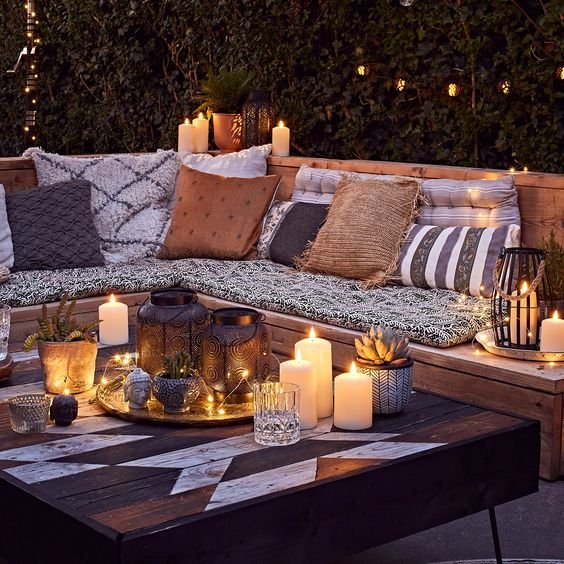
Ideas:
- String Lights: Hang string lights across pergolas or between trees for a magical nighttime ambiance.
- Solar-Powered Lights: Install solar-powered lights along pathways and in garden beds for eco-friendly illumination.
- Spotlighting: Use spotlights to highlight architectural features or focal points like water features.
- Candle Holders: Place candle holders on tables or in nooks for a flickering, intimate atmosphere.
Best Practices:
- Layered Lighting: Combine different types of lighting to create depth and interest throughout the garden.
- Energy Efficiency: Opt for LED or solar-powered lights to reduce energy consumption and maintenance.
- Lighting Control: Install timers or smart lighting systems for convenient control of garden illumination.
- Safety Considerations: Ensure pathways and seating areas are well-lit to prevent accidents at night.
- Maintenance: Regularly clean and inspect lights to ensure they are functioning properly and safely.
7. Water Features
Water features are one of the best Moroccan garden ideas that play an important role in their design and cultural significance and are renowned for their exquisite beauty. These water features not only enhance the visual appeal of the gardens but also serve practical purposes.
In Moroccan culture, water symbolizes life and purity, and its presence in gardens symbolizes prosperity and abundance.
The sound and sight of flowing water make you feel relaxed. Fountains, ponds, and cascades are common sights in Moroccan gardens, offering respite from the heat and providing a sense of serenity.
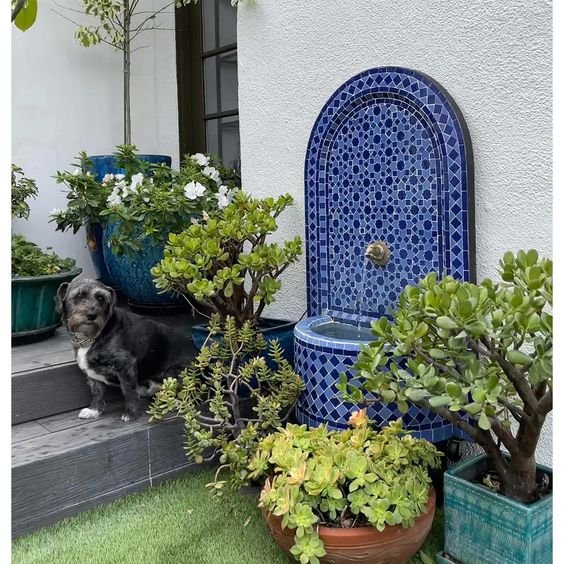
Ideas:
- Fountains: Install tiered fountains with intricate tile work or sculptural elements as a central feature.
- Ponds: Create reflective ponds bordered by lush vegetation for a serene and cooling effect.
- Cascades: Design cascading water features that mimic natural streams or waterfall effects.
- Water Walls: Construct vertical water walls with Moroccan-style tiles or mosaics for a dramatic backdrop.
- Aquatic Plants: Integrate water lilies or other aquatic plants to enhance the natural beauty of water features.
Best Practices:
- Water Quality: Maintain water clarity and purity through filtration systems or regular cleaning.
- Pump Maintenance: Service pumps and filtration equipment to ensure proper functioning and longevity.
- Safety Measures: Install barriers or covers to protect children and pets from accessing deeper water features.
- Seasonal Care: Adjust water levels and plant care seasonally to accommodate weather changes.
- Sound Optimization: Position water features strategically to optimize soothing sound effects throughout the garden.
8. Unique Architecture
Traditional architecture and structures within Moroccan gardens contribute greatly to creating an enchanting and harmonious atmosphere. Moroccan gardens are known for their unique combination of natural beauty and architectural splendor.
Intricate geometric patterns are a hallmark of Moroccan garden architecture. From the tiled floors to the carved wooden ceilings, these patterns are meticulously designed to create a sense of symmetry and balance in the space.
In addition to adding to the visual appeal of the gardens, pavilions, and pergolas are also decorated with beautifully carved motifs and vibrant colors.
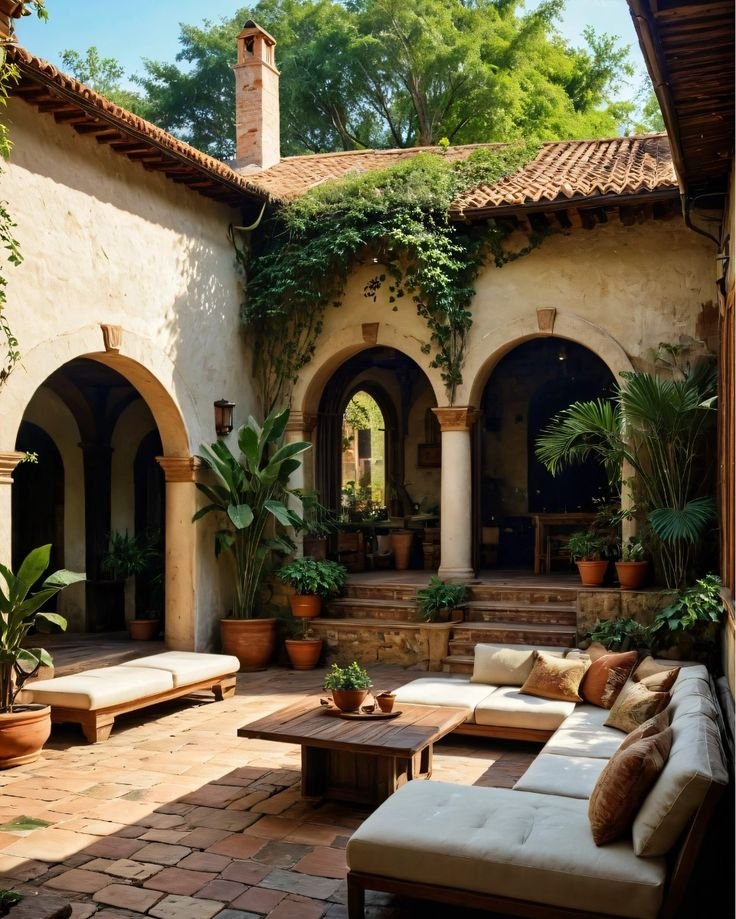
Ideas:
- Pavilions and Gazebos: Build or repurpose structures with intricate architectural details for shade and relaxation.
- Arches and Gateways: Frame garden entrances with ornate arches or gateways adorned with Moroccan motifs.
- Carved Ceilings: Install wooden or plaster ceilings with geometric patterns and vibrant colors.
- Moroccan Tiles: Use mosaic or Zellige tiles to decorate walls, floors, and even ceilings of garden structures.
- Open-air Rooms: Create open-air rooms or alcoves within the garden for dining or lounging.
Best Practices:
- Authenticity: Research traditional Moroccan architectural styles and materials for authenticity.
- Structural Integrity: Ensure that all architectural features are built to withstand local weather conditions.
- Permitting: Obtain necessary permits and approvals for the construction or renovation of garden structures.
- Integration: Seamlessly integrate architectural elements with existing garden features and landscaping.
- Maintenance: Regularly inspect and maintain structures to preserve their beauty and structural integrity over time.
9. Awnings
Placing awnings is one of the best home garden ideas to spruce up your outdoor Moroccan garden space. Marrakesh’s roof terraces are a common sight with earthy-toned sails, which provide protection from the harsh North African sun and also create a nomadic Berber atmosphere, especially when hoisted over low daybeds.
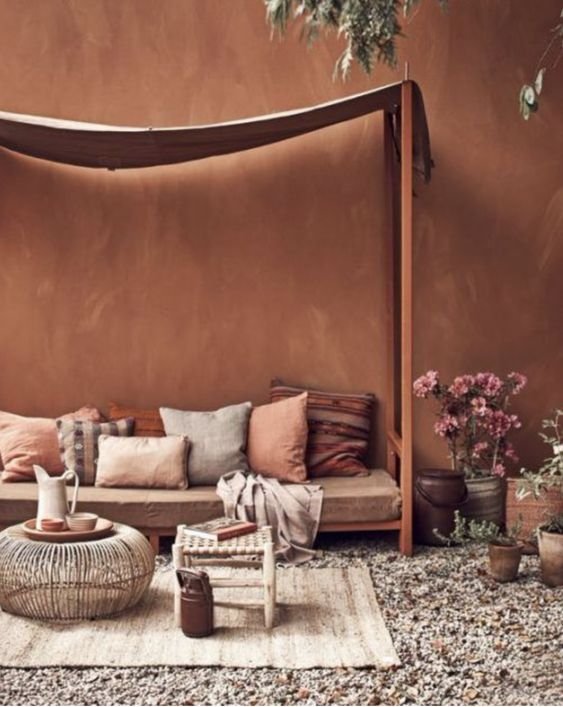
Ideas:
- Fabric Selection: Choose earth-toned fabrics that complement Moroccan-inspired decor and protect from the sun.
- Versatile Designs: Opt for retractable awnings that provide flexibility in sun exposure and outdoor use.
- Berber Influence: Emulate Berber tent designs with draped fabrics that create a nomadic ambiance.
- Integrated Seating: Pair awnings with low seating or dining areas to create shaded, comfortable spaces.
- Decorative Edge: Add tassels or fringe to awning edges for a touch of Moroccan textile tradition.
Best Practices:
- Weather Resistance: Select awnings made from durable, weather-resistant materials to withstand elements.
- Installation Quality: Ensure awnings are securely anchored and properly tensioned to prevent sagging or damage.
- Maintenance: Clean awnings regularly and store them properly during inclement weather to extend their lifespan.
- UV Protection: Verify that awning fabrics provide adequate UV protection for health and comfort.
- Aesthetic Continuity: Coordinate awning colors and patterns with other garden elements for a cohesive design.
10. Marrakech corners
Employing Marrakesh corners with Moroccan rugs, kilim pillows, and coffee tables is one of the best Moroccan garden ideas that you can opt for. If you have drought-tolerant plants, place them in the background.

Ideas:
- Textile Accents: Decorate with Moroccan rugs, pillows, and textiles to create a cozy, cultural ambiance.
- Tea Tables: Include low tea tables or trays with Moroccan tea sets for authentic cultural immersion.
- Drought-Tolerant Plants: Integrate plants like succulents and cacti that thrive in arid Moroccan climates.
- Artisanal Crafts: Display handmade pottery, metalwork, or woodworking pieces for artisanal flair.
- Reflective Surfaces: Use mirrors or metallic accents to enhance light and create a sense of spaciousness.
Best Practices:
- Cultural Sensitivity: Respect and incorporate elements of Moroccan culture authentically and respectfully.
- Functional Design: Ensure seating and tables are comfortable and practical for intended use.
- Plant Care: Provide appropriate care for drought-tolerant plants to maintain health and appearance.
- Artisan Support: Purchase artisanal crafts directly from Moroccan artisans to support local traditions.
- Personalization: Tailor design elements to reflect personal preferences while honoring Moroccan influences.
11. Fire Pit
Adding a fire pit to your garden is one of the best Moroccan garden ideas that will make your guests gather and linger. If your space is larger, you can combine a few fires with lanterns to light a path and define areas.
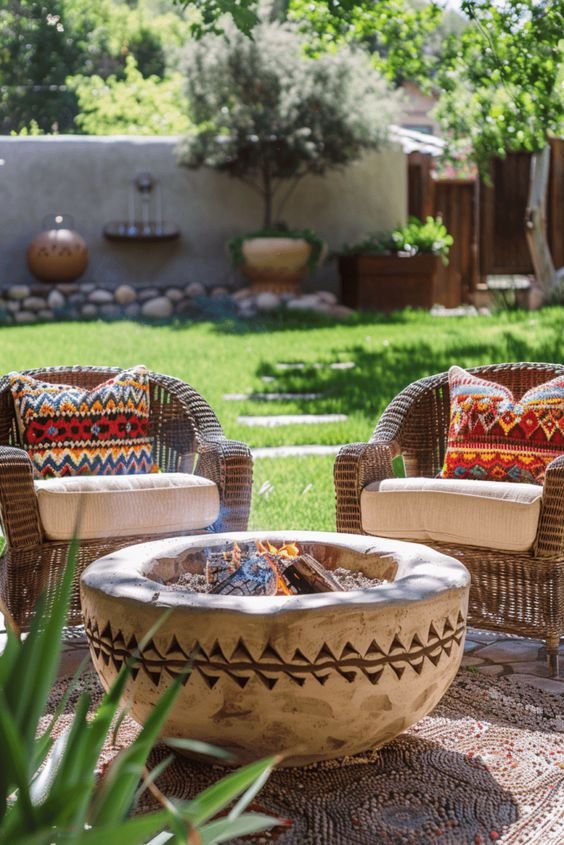
Ideas:
- Central Gathering Point: Position the fire pit as a focal point for seating areas, encouraging social gatherings.
- Moroccan Design Elements: Surround the fire pit with Moroccan tiles or decorative patterns to enhance the ambiance.
- Multi-Functional: Design the fire pit with a removable grill for cooking, adding versatility to outdoor dining.
- Natural Integration: Use natural stone or earth-toned materials to blend the fire pit seamlessly into the garden landscape.
- Safety Features: Install a fire pit with a safety screen or cover to prevent sparks and control flames.
Best Practices:
- Fire Safety: Place the fire pit on a fire-resistant surface away from overhanging branches or flammable materials.
- Ventilation: Ensure adequate airflow around the fire pit to maintain a safe and efficient burn.
- Legal Compliance: Check local regulations and obtain any necessary permits before installing a fire pit.
- Maintenance: Clean the fire pit regularly to remove ash and debris, and inspect for any signs of wear.
- Storage: Cover the fire pit or store accessories like grates and tools in a dry, protected area when not in use to extend their lifespan.
12. Potted fruit trees
In order to recreate the Moroccan theme in your garden, plant fruit trees. You can portray your garden as the best-looking Moroccan beauty with these potted fruit trees. Consider the following fruit trees to make the best garden.

Ideas:
- Citrus Varieties: Plant dwarf citrus trees like lemon, lime, or mandarin in large pots for a Mediterranean feel.
- Espaliered Fruit Trees: Train fruit trees against walls or trellises in pots to save space and add vertical interest.
- Seasonal Rotation: Rotate fruit trees in and out of pots based on seasons to maximize growth and fruit production.
- Decorative Elements: Use decorative pots and containers that complement the Moroccan garden theme, such as colorful ceramic or terra cotta.
- Edible Landscape: Integrate fruit trees into garden beds or along pathways to create a functional and beautiful landscape.
Best Practices:
- Container Selection: Choose pots with adequate drainage and large enough to accommodate root growth.
- Soil Quality: Use well-draining, nutrient-rich soil specific to fruit trees in containers.
- Watering Schedule: Establish a consistent watering schedule to ensure soil moisture without waterlogging.
- Pruning and Thinning: Regularly prune and thin branches to maintain tree shape and encourage fruit production.
- Fertilization: Feed fruit trees with a balanced fertilizer according to their growth stage and seasonal needs.
Conclusion
Therefore, creating a Morrocan-style garden is as simple as that! Whether you opt for lush evergreen shrubs, stunning wrought iron decor, cozy low-seating areas, etc. each choice contributes to the enchanting ambiance of the garden. By incorporating Moroccan garden ideas and best practices, you can create a garden that perfectly recreates the Moroccan ambiance space. So why wait? Create a peaceful retreat right in your own backyard, where every moment feels like a journey to a distant, magical land!

